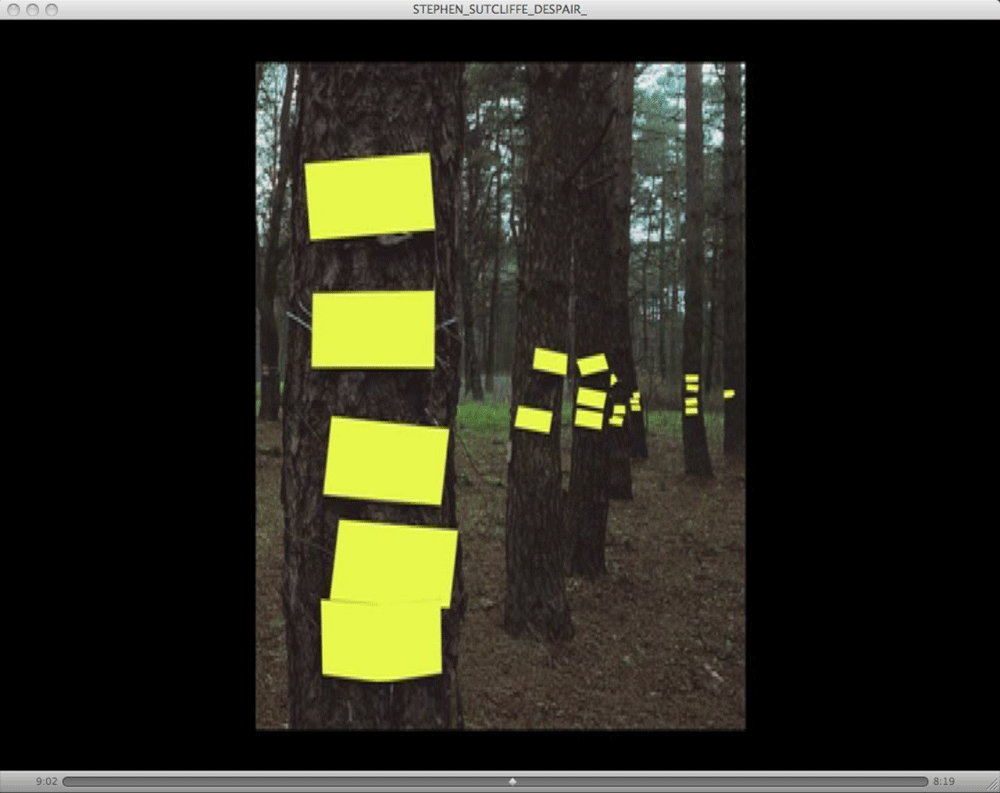Stephen Sutcliffe
Taped footage, poems and archival material; collage, splicing and cheap effects
Taped footage, poems and archival material; collage, splicing and cheap effects
On YouTube you can find a clip from a 1970 BBC documentary, The Crimes of Joe Orton, about the arrest of the playwright and his lover Kenneth Halliwell for defacing books borrowed from a London library. They had altered dust-jacket blurbs and pasted photographs onto covers – a monkey’s face on a history of the Tudors, say, or a heavily tattooed man on the front of a John Betjeman biography. These additions – ‘sometimes amusing, sometimes mildly obscene’, as the librarian puts it – landed the pair with a six-month prison sentence in 1962, five years before Halliwell bludgeoned Orton to death with a hammer.
Though the clip is not by Stephen Sutcliffe, it has several things in common with the videos that the Glasgow-based Yorkshireman has been making for the past ten years: it is little more than five minutes long, has the straight-laced humour of a somewhat nebulous, pre-MTV period of paternalistic British television programming, and involves a collage technique with a rather laissez-faire attitude to publicly available materials. Disgruntled librarian Jim Connell gives a succinct description of Orton and Halliwell’s methods that tallies with the techniques favoured by Sutcliffe: ‘Most of these blurbs were written […] so that one started reading almost without realizing that this was a thing which had been doctored.’

Made on FinalCut editing software, from an archive of audio files and more than 1,000 VHS tapes, which the artist has been acquiring for some 25 years, Sutcliffe’s videos do not appear to have composite structures. Despite this, they often combine taped footage – both familiar and previously unscreened – with spoken word, cheap-looking digital effects and music into one- or two-minute videos. His work often has that hard-to-define quality of being a pre-existing, unedited out-take, which is what I assumed We’ll Let You Know (2008) was when I first saw it. (The visual source for the one-minute video derives, as other works of Sutcliffe’s do, from the extensive Lindsay Anderson archive.) As part of an RSC workshop televised in the late 1970s, a young Ian McKellen holds forth on the subject of Shakespearean versification, before pontificating about a Maurizio Pollini performance of a Beethoven piano sonata. Muttered heckling, which appears to be coming from an out-of-shot spectator, is provided by a sketch by British comedian Peter Sellers, in which he plays a director addressing a verbose actor: ‘Oh God … Get him out of here!’ Mid-flow, McKellen pauses, searching for a word; a look of fear momentarily freezes him. Sutcliffe’s videos are full of these small anxieties, which often attend a public reading; the fear of appearing pretentious is never far away.
Crucial to this is Sutcliffe’s British cast of class-conscious social commentators – Alan Bennett, Monty Python and The Smiths all feature – and wayward intellectuals such as Anthony Burgess, Christopher Logue and Colin Wilson. The latter reads from his poem in O Come All Ye Faithful (2008), which finishes with the emphatic line: ‘Love comes again.’ A tentative happy ending is suggested, but then Logue glances anxiously off-camera, asking: ‘Did I read it right or should I do it again?’ Like a worried internal monologue, beneath his reading plays a hushed litany of obscenities, cut and pasted from the The F**king Fulfords (a 2004 documentary about a foul-mouthed, and cheerfully destitute, aristocratic English family). Hopefulness is always talkative and fretful; his speakers are all haunted by the same (very British) worry: ‘What if I fuck up?’
Sutcliffe’s approach to collage is predicated on the technique being an act of speedy cross-referencing. The logic of the join – what Sutcliffe calls ‘the connective point’ – is sometimes intuitive and sometimes oblique, giving an unsettling effect too nebulous to place. Shown as part of his 2009 solo show at Cubitt in London, the hinge in an untitled work from last year is a Chopin prelude: Sutcliffe noticed that it forms the basis for Barry Manilow’s ‘Could it be Magic’ (1973) and is also used as an interlude between chapters in Pier Paolo Pasolini’s film Salò, or the 120 Days of Sodom (1975). Sutcliffe slows a scene from it, in which young girls present their bedpans for inspection, and backs it with the Manilow song (though the music doesn’t seem to accompany the piece – here, as elsewhere in his work, there is an equity between the audio and visual components). The creepy result of this submerged relationship is something like an unasked-for music video.
The structure of collaged elements is considerably more complex in Despair (2009), which, at 17 minutes, is Sutcliffe’s longest work to date. It takes Vladimir Nabokov’s eponymous black farce from 1934, as well as Rainer Werner Fassbinder’s 1978 film adaptation, as a vague template, though its density resembles a film adaptation based on the back of a book rather than its actual content. Whilst alluding to the themes of Nabokov’s novel – doubling, vanity and insecurity – Despair also incorporates Kenneth Anger’s Eaux d’Artifice (Fireworks, 1953), the BBC2 logo, a Logue poem, an interview with Fassbinder and music by 17th-composer Jean-Baptiste Lully, among many other things. Its range of referentiality asserts an old-style belief in collage’s potential to render a certain kind of difficulty or disruption, but its approach is quiet, even bookish.
























